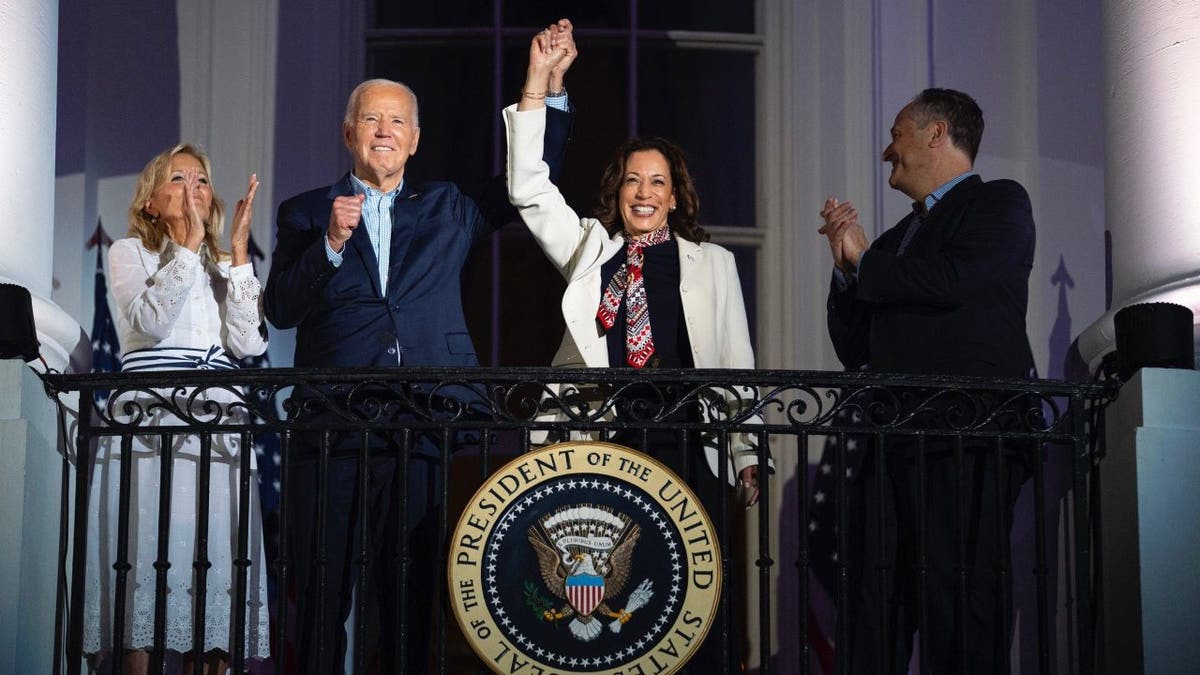INTERNACIONAL
Newsom debuts rapid-response website as critics accuse him of prioritizing presidential ambitions

Gov. Gavin Newsom, D-Calif., a potential 2028 presidential candidate, launched a new fact-check website on Wednesday targeting «right-wing misinformation,» as a new poll found more than half of California registered voters believe he is more focused on becoming president than delivering for Californians.
Newsom’s campaign apparatus described the new fact-check website as a «rapid-response website to set the record straight about the Golden State» and President Donald Trump.
A new survey conducted by UC Berkeley’s Institute of Governmental Studies and co-sponsored by the Los Angeles Times found that 54% of California registered voters believe Newsom is more focused on his personal presidential ambitions than solving the ongoing problems at home in the Golden State.
«By a more than a two-to-one margin (54% to 26%), most voters believe that as Newsom serves out his final two years as governor, he is devoting more of his attention to things that might benefit himself as a possible candidate for president than to governing the state and helping to solve its problems,» according to the results of the poll completed April 21-28 among 6,201 registered voters in California.
TRUMP DARES NEWSOM TO RUN IN 2028, SLAMS RECORD ON LA WILDFIRES
California Gov. Gavin Newsom, left, has rejected President Donald Trump’s first 100 days back in the White House. (Getty Images/AP)
Newsom’s campaign, in a press release announcing the new fact-checking endeavor, touted California as the fourth-largest economy in the world, and said the blue state’s population is growing, crime rates are at historic lows and California is leading the nation in clean energy and tech innovation.
WHITMER DITCHES DEM PLAYBOOK ON TRUMP’S TARIFFS AMID 2028 SPECULATION
«This site is for everyone sick of the BS about California. We’re done letting the MAGA trolls define the Golden State. We’re going on the offense and fighting back — with facts,» Newsom said.
Newsom’s latest endeavor targets misinformation from the devastating Los Angeles fires this year and other state issues, including crime, climate, the economy, immigration, energy and housing. California is often ridiculed by Republicans as a representation of the demise of Democratic states. Such was the case last month when a California lawmaker proposed a bill to allow state college and university students to sleep in their cars amid the blue state’s housing crisis.
The California politician has long been rumored to harbor presidential ambitions. He was one of several names floated as a potential Democratic nominee replacement for President Joe Biden before Biden suspended his re-election campaign last summer and ultimately chose former Vice President Kamala Harris as his successor. Newsom also campaigned for Biden and Harris in key battleground states, acting as a surrogate for both candidates when their names were on the top of the ticket.

First lady Jill Biden and second gentleman Doug Emhoff watch as President Joe Biden raises the hand of Vice President Kamala Harris on July 4, 2024. (AP Photo/Evan Vucci)
Newsom launched a podcast this year embracing political dialogue across party lines, following Democrats losing the White House and the Senate and failing to regain the House of Representatives in 2024. Newsom has invited Trump allies and conservative guests, including Charlie Kirk and Steve Bannon, onto his podcast in an attempt to show he is open to «criticism and debate without demeaning or dehumanizing one another.»
The strategy follows criticism after the 2024 election that Democrats didn’t prioritize new media appearances and unscripted conversations enough.
But Newsom’s willingness to soak up the national spotlight as Democrats look for someone to lead the party into the next generation may have backfired among his California constituents.

California Gov. Gavin Newsom greets President Donald Trump on the tarmac in California following the Los Angeles fires. (Pool)
Newsom is one of several Democratic governors trying to balance diplomacy with rejecting Trump’s agenda during the president’s second term. Newsom has spoken out against Trump’s tariff policies and executive orders while reaching across the aisle to secure disaster relief following the Los Angeles fires earlier this year.
The poll found a majority of California voters believe the state would be negatively impacted by Trump’s overhaul of the federal government, as 64% believe Trump’s tariffs would negatively impact California business and agriculture and over 50% believe Trump’s policies would have a negative impact on education.
CLICK HERE TO GET THE FOX NEWS APP
Meanwhile, Californians are split on Newsom’s job performance, with 46% both approving and disapproving of his job as governor and 45% reporting they are not confident in «his ability to be effective in looking out for California’s interests when dealing with the Trump administration.»
«The Governor is focused on one thing: his job — driving L.A.’s recovery, confronting the housing crisis, and taking Donald Trump to court over his disastrous tariffs that are raising costs for families and blowing a hole in California’s budget,» Newsom’s office told Fox News in response to the new polling.
Politics,Elections,California,Gavin Newsom
INTERNACIONAL
La guerra con Rusia: la niebla y la lluvia frenan a los drones de Ucrania y favorecen los asaltos rusos

La niebla persistente y las frecuentes lluvias ofrecen cobertura a la infantería rusa frente a los drones ucranianos, lo que permite a las fuerzas de Moscú intensificar los asaltos que lanza en el frente.
Los soldados ucranianos dicen que el tiempo desfavorable que ha dominado durante buena parte del último mes ha reducido drásticamente la efectividad de los vehículos aéreos no tripulados que son el puntal de su defensa en el este del país.
«En cuanto hay niebla, los asaltos rusos se intensifican», dijo a EFE Anatoli Repsh, sargento jefe de un batallón que está combatiendo cerca de Kúpiansk, en la región nororiental de Járkov.
La unidad de Repsh recurre a una combinación de drones de reconocimiento y de ataque para detectar y eliminar a los soldados rusos que avanzan a pie -a menudo de manera individual o en parejas- como parte de los intentos diarios por infiltrarse más allá de las posiciones ucranianas.
La lluvia y la niebla no solo limitan la visibilidad, sino que también dañan rápidamente las cámaras de los drones y otros componentes electrónicos delicados.
«Aún con lluvia y niebla intentamos volar, pero el equipamiento se resiente mucho. Un dron que ha estado operando todo el día bajo la lluvia rara vez aguanta más de dos o tres días», dijo Repsh.
La escasez de drones lleva a los soldados a usar el equipamiento de forma más conservadora cuando las condiciones meteorológicas son malas y recurren en cambio a interceptar comunicaciones para detectar al enemigo, así como a obstáculos de alambre de espino y campos minados para ralentizar su avance.
Solo una vez que localizan a la infantería rusa envían los drones para atacarla.
Repsh calcula que aproximadamente tres cuartos de los atacantes mueren o son heridos mientras intentan atravesar la «zona de la muerte» de entre siete y diez kilómetros que separa a los dos ejércitos.
Los que sobreviven, sin embargo, se van acumulando gradualmente, lo que obliga a las unidades ucranianas a gastar aún más recursos para repelerles.
«Ya no tenemos infantería suficiente para recuperar con contraataques el terreno perdido y tenemos que gastar más drones, cuando el tiempo lo permite, para destruir las casas y posiciones en las que se esconden los rusos», explicó el sargento.
Pese al clima adverso y a su impacto sobre algunas unidades que dependen casi exclusivamente de los drones para mantener la línea de defensa, las fuerzas ucranianas han impedido hasta ahora que los rusos irrumpan en un avance brusco.
Aún así los progresos territoriales de Moscú se aceleraron en noviembre, cuando según la plataforma de análisis DeepState alcanzaron 505 kilómetros cuadrados, la misma superficie que en los dos meses anteriores combinados.
En Vovchansk, una pequeña ciudad fronteriza que lleva más de un año y medio bajo asedio, la densa niebla ha permitido a las tropas rusas acelerar sus avances en semanas recientes.
«Los drones están volando mucho menos y los rusos están aprovechando su superioridad numérica», dijo este viernes el portavoz militar regional Víktor Tregúbov.
En Pokrovsk, en la región de Donetsk, se está dando una situación similar, pues la espesa niebla ha facilitado la infiltración y acumulación por parte de la infantería rusa en la ciudad y sus inmediaciones.
El mal tiempo también protege los movimientos ucranianos de los drones kamikaze rusos, lo que está facilitando el transporte de munición y alimentos a las posiciones más avanzadas, así como la evacuación de heridos y la rotación de personal.
«Para nosotros es más fácil cuando hay niebla, lluvia intensa o vientos fuertes, porque lanzan menos drones de ataque», dijo a EFE Vasil Vovk, un soldado que está combatiendo en el frente del este.
Sin embargo, la incapacidad de usar los drones tanto como en condiciones meteorológicas favorables hace más daño a Ucrania que a Rusia, enfatizan los soldados, porque Moscú es superior en número de efectivos, así como en la artillería y en el uso de bombas aéreas guiadas, que dependen menos del tiempo.
Los ingenieros ucranianos trabajan en soluciones que hagan a los drones menos vulnerables a los efectos climatológicos, pero la niebla y la lluvia ponen de manifiesto la necesidad persistente de armas convencionales.
Aunque Ucrania ha incrementado de forma drástica la producción doméstica de drones y está buscando financiación adicional para seguir expandiéndola, los sistemas de artillería, los vehículos blindados y las defensas antiaéreas modernas siguen siendo indispensables para detener los avances rusos, dicen soldados y analistas militares.
INTERNACIONAL
Trump adds his birthday as free national park day while axing MLK Day and Juneteenth

NEWYou can now listen to Fox News articles!
The Trump administration is reshaping when Americans can enter national parks for free – adding President Donald Trump’s birthday as a fee-free day while eliminating Martin Luther King Jr. Day and Juneteenth in a move already drawing criticism from civil rights leaders.
Although presidents often revise the list, the changes are sparking criticism from civil rights advocates and Democratic lawmakers who say the removals undercut holidays that honor Black Americans’ history and contributions.
The shift in free-entry days marks a notable break from the 2025 calendar, which leaned heavily on long-established public lands celebrations and civil rights observances.
This year’s lineup included Martin Luther King Jr. Day, Juneteenth, National Public Lands Day, and the kickoff to National Park Week – all of which disappear under the 2026 schedule.
TOP TRUMP DEPARTMENT ROLLS OUT CHRISTMAS TREE SAVINGS PLAN: ‘MAKING THIS SEASON BRIGHTER’
Yosemite National Park visitors take a look at El Capitan rock formation and Bridalveil Fall from Tunnel View in Yosemite Valley in California. (Craig Kohlruss/Fresno Bee/Tribune News Service via Getty Images)
In their place, the Trump administration has added a slate of historically themed or presidentially-aligned dates. President Donald Trump’s birthday on June 14 becomes a fee-free day for the first time, as do Constitution Day, the 110th anniversary of the National Park Service, and the birthday of Theodore Roosevelt.
The agency is also shifting some observances to federal holidays with broader national recognition, including Presidents’ Day, Memorial Day and a three-day Independence Day weekend.
YOSEMITE RANGERS BUST OUTLAW JUMPERS OFF EL CAP — ZERO TOLERANCE, SHUTDOWN OR NOT

The Trump administration is making changes to which days the public will be able to access National Parks for free in 2026, adding President Donald Trump’s birthday as one day, and removing Martin Luther King Jr. Day and Juneteenth. (Rick Bowner/AP Photo)
Veterans Day remains the lone date carried over from both years, underscoring how dramatically the free-day calendar is being remade heading into 2026.
FOX 5 in DC reported that some civil rights leaders have voiced opposition to the changes.
National Parks Conservation Association spokesperson Kristen Brengel told the station that the elimination of Martin Luther King Jr. Day is concerning, adding that the day had become a popular day of service for community groups that use it to conduct volunteer projects at the parks.
SQUATTERS TAKE OVER YOSEMITE AS SHUTDOWN LEAVES POPULAR NATIONAL PARK WITH FEW RANGERS: REPORT
Sen. Catherine Cortez Masto, D-Nev., also weighed in on the changes in a post on X on Friday.
«Let’s be clear here: both MLK Jr. Day and Juneteenth were free entry days last year,» she wrote. «The President didn’t just add his own birthday to the list, he removed both of these holidays that mark Black Americans’ struggle for civil rights and freedom. Our country deserves better.»
Fox News Digital has reached out to the White House regarding the changes.
AMERICA’S NATIONAL PARKS ARE AT A CROSSROADS. HERE’S HOW CONGRESS CAN PROTECT THEM

An entrance sign for Colorado’s Rocky Mountain National Park. (John Greim/LightRocket via Getty Images)
The Department of Interior is pairing the new free-day schedule with a broader overhaul of how visitors access national parks beginning Jan. 1, 2026.
The agency is rolling out fully digital America the Beautiful passes – including annual, military, senior, fourth-grade and access passes – that can be purchased and displayed on mobile devices through Recreation.gov. Visitors will be able to activate passes instantly and still link them to physical cards if needed.
Officials say updated validation tools and new training for park staff are intended to speed up entrance lines and simplify visitor experiences across the system.
NATIONAL PARK SERVICE ANNOUNCES IT WILL RESTORE, REINSTATE STATUE HONORING CONFEDERATE GENERAL ALBERT PIKE

Yellowstone National Park sign and entrance. President Trump added his birthday to the list of dates that people can enter national parks for free. (iStock)
«President Trump’s leadership always puts American families first,» Secretary of the Interior Doug Burgum said. «These policies ensure that U.S. taxpayers, who already support the National Park System, continue to enjoy affordable access, while international visitors contribute their fair share to maintaining and improving our parks for future generations.»
The department is also refreshing annual pass designs with new patriotic artwork that will appear on both digital and physical versions.
Alongside the digital rollout, the administration announced it is shifting its fee structure to emphasize lower costs for U.S. residents and higher prices for international visitors.
The annual pass will remain $80 for Americans but jump to $250 for nonresidents. Foreign visitors who do not hold a pass will pay an added $100 per person at 11 of the most visited national parks.
CLICK HERE TO DOWNLOAD THE FOX NEWS APP
The agency is also broadening access for motorcycle riders by allowing all America the Beautiful passes to cover two motorcycles instead of one.
Interior officials say the increased revenue from higher nonresident fees will be directed toward facility upgrades, maintenance projects, and visitor services across the park system.
national parks,donald trump,parks
INTERNACIONAL
Chechen leader threatens Zelenskyy amid drone strike, echoes alleged assassination plot

NEWYou can now listen to Fox News articles!
Chechen leader Ramzan Kadyrov’s threats against Ukraine following a drone strike echo a 2022 plot to infiltrate Kyiv and target President Volodymyr Zelenskyy, a former Ukrainian government official has said.
The leader’s latest threat came after a Ukrainian drone reportedly struck a high-rise building near Kadyrov’s home in Grozny on Nov. 5.
The strike prompted the Chechen strongman to vow retaliation in an online video post, according to Reuters.
«This new threat would just be another assassination threat for Zelenskyy. The Chechens are really serious about revenge,» a former government official told Fox News Digital.
RUSSIAN CRUISE MISSILES HIT US COMPANY IN MASSIVE UKRAINE STRIKE AMID TRUMP’S PEACE PUSH
Head of Chechnya Ramzan Kadyrov smiles prior to Russian-UAE talks on December 6, 2023, in Abu Dhabi, United Arab Emirates. (Getty Images)
«But in Kyiv they are not panicking about this like they were in 2022,» the former official said under condition of anonymity.
«Zelenskyy is now better protected, feels more powerful and is less fragile,» they said.
The recent Ukrainian strike, reported by Reuters, hit the 28-story Grozny-City tower that sits roughly 830 meters from Kadyrov’s home.
TRUMP EYES NEW SANCTIONS ON PUTIN AFTER LARGEST-EVER DRONE ATTACK

Ramzan Kadyrov is one of Vladimir Putin’s most aggressive enforcers. (Rob Welham/Universal History Archive/Universal Images Group via Getty Images)
Kadyrov, who is loyal to Russia, later allegedly confirmed the attack in a Telegram post, stating there were no casualties, but he condemned the strike as making «no tactical sense.»
He also warned that retaliation was imminent.
«Starting tomorrow and in the course of the week, the Ukrainian fascists will be feeling a stern response,» he threatened.
Unlike Ukraine’s strike, he added, «we will not be making a cowardly strike on peaceful targets,» per Reuters.
Ukrainian attacks have hit sites in Chechnya before now, including a police barracks and a training academy. Chechen units were also deployed during Russia’s 2022 invasion and were among the Kremlin’s most loyal forces.
RUSSIA LAUNCHES MASSIVE DRONE AND MISSILE BARRAGE ON UKRAINE HITTING KYIV, OTHER TARGETS THROUGHOUT COUNTRY

Russian and Chechen soldiers in a devastated Mariupol neighborhood close to the Azovstal frontline. (Maximilian Clarke/SOPA Images/LightRocket via Getty Images)
At the time of the 2022 invasion, the official said there was intense anxiety in Kyiv.
«At the beginning of the large-scale invasion in 2022, Chechens were sent to Kyiv to murder top politicians,» the former official said.
«This included Volodymyr Zelenskyy and top politicians from the government and security services and Parliament, and many other agencies.
«Zelenskyy and Yermak were very scared,» they claimed. «They were calling from the office, asking some people in the military and security service to secure the metro station in Kyiv.»
The source said one metro station in Kyiv was a potential infiltration route for the Chechens into Zelenskyy’s presidential bunker.
RUSSIAN ATTACK ON UKRAINE LEAVES 25 DEAD IN TERNOPIL AFTER MASSIVE OVERNIGHT STRIKES

Ukraine’s President Volodymyr Zelensky gives a press conference in Kyiv on February 26, 2025, amid the Russian invasion of Ukraine. (Tetiana Dzhafarova/AFP via Getty Images)
At the time, the station in Kyiv that was deep underground and near the presidential bunker, was viewed as the most vulnerable entry route, the source said.
«They were afraid that Chechens would get to the bunker through this metro station, but in the end the Chechens were killed before they reached Kyiv.
«They tried to reach Kyiv, somehow downtown, somehow via the river, but it’s quite a complicated way to get there,» the former official said.
Meanwhile, with the Nov. 5. Grozny strike landing so close to his home, Kadyrov, already one of Putin’s most aggressive enforcers, is signaling a harsher stance as attacks reach inside Russian territory.
The Moscow Times reported that the drone struck a building that houses regional government offices, including the Chechen Security Council and agencies connected to tourism and religious affairs.
CLICK HERE TO DOWNLOAD THE FOX NEWS APP
Despite the rhetoric, the former Ukrainian official claimed Zelenskyy is unfazed this time around.
«These days, Zelenskyy isn’t afraid of Kadyrov’s actions against him or the Ukrainian people. Zelenskyy is feeling very powerful right now,» they added.
Fox News Digital has reached out to Zelenskyy’s office for comment.
volodymyr zelenskyy,ukraine,russia,vladimir putin,wars

 POLITICA1 día ago
POLITICA1 día agoEl curioso sticker pegado en uno de los aviones F-16 y la explicación oficial: “En honor al Presidente”

 CHIMENTOS3 días ago
CHIMENTOS3 días agoSabrina Rojas dijo lo peor de Pampita al aire por error y murió de vergüenza: “Está muy…”

 DEPORTE1 día ago
DEPORTE1 día agoInter Miami de Lionel Messi y Rodrigo de Paul venció 3-1 a Vancouver y es campeón de la MLS Cup


























